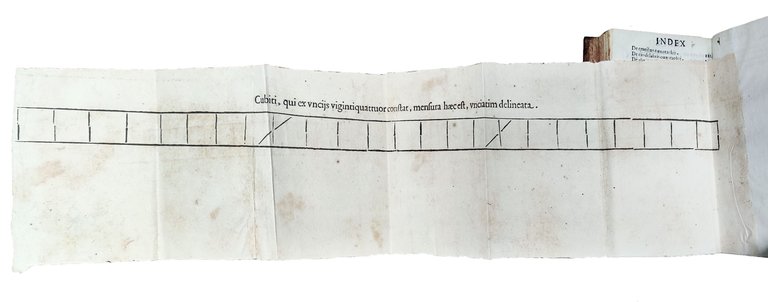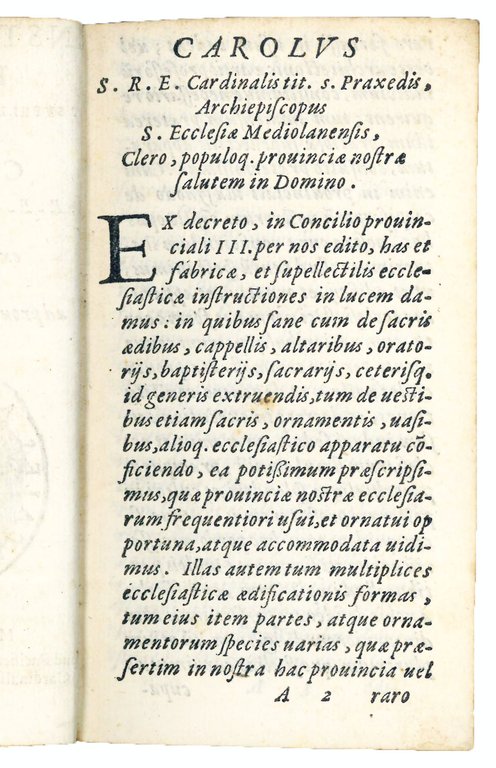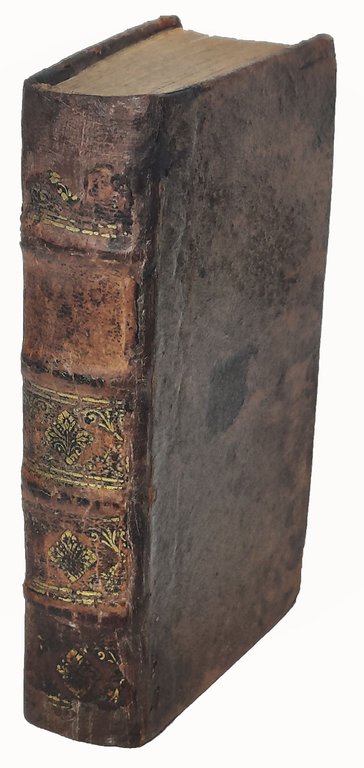



Rare and modern books
BORROMEO, Carlo (1538-1584)
Instructionum fabricae, et supellectilis ecclesiasticae libri II
Pacifico da Ponte, 1577
12500.00 €
Govi Libreria Antiquaria
(Modena, Italy)
The correct shipping costs are calculated once the shipping address is entered during order creation. One or more delivery methods are available at the Seller's own discretion: Standard, Express, Economy, In-store pick-up.
Bookshop shipping conditions:
For items priced over €300, it is possible to request an instalment plan from Maremagnum. Payment can be made with Carta del Docente, Carta della cultura giovani e del merito, Public Administration.
Delivery time is estimated according to the shipping time of the bookshop and the courier. In case of customs detention, delivery delays may occur. Any customs duties are charged to the recipient.
For more infoPayment methods
- PayPal
- Credit card
- Bank transfer
-
-
Find out how to use
your Carta del Docente -
Find out how to use
your Carta della cultura giovani e del merito
Details
Description
12mo (132x73 mm). 213, [9] leaves and a folding woodcut diagram. Collation: A-S12 T6. The last leaf is a blank. With the woodcut device of Carlo Borromeo on the title page. 18th-century vellum, gilt spine with trace of a missing lettering spine, marbled endleaves, sprinkled edges (rubbed, worn, spine restored). On the front flyleaf ownership entries: “Ad usum Abbatis Herculis Sfondrati Canonici Ordinarij Metropolis Med.ni” and “nunc vero Can.ci Ord.i Christophori Bazetti”. Upper margin cut short occasionally affecting the running title, some marginal staining, plate slightly browned, tiny hole on about the last five leaves not affecting the text, one line of text anciently covered with a paper strip on l. M5, all in all a good copy.
Rare first edition of this treatise that had a profound effect on art and architecture not only of the time, but also in subsequent centuries (cf. N. Benazzi-M. Marinelli, La fortuna dell'opera, in: “C. Borromeo, Instructionum fabricae, et supellectilis ecclesiasticae libri II, 1577”, S. della Torre & M. Marinelli, eds., Città del Vaticano, 2000, pp. VII-VIII).
Deeply influenced by the decrees of the Council of Trent, Borromeo believed that religious art should be clear and direct; that it should educate the spectator and move him to penance. In the Instructionum fabricae he set out his proposals for the reform of church architecture and decoration. The first section of thirty-three chapters concerns the building and its interior. The second book pertains with scrupulous exactitude and meticulous detail to ecclesiastical furnishing. E.g., in chapter seventeen, where he discusses the representation of sacred events, he stipulates punishment or fine for painters and sculptors who deviate from his prescribed guidelines for decorum. He believed that portraits should be as accurate as possible and that the depiction of animals, except in a biblical or hagiographical context, should be prohibited (cf. E.C. Voelker, Borromeo's Influence on Sacred Art and Architecture, in: “San Carlo Borromeo”, J.M. Headley & J.B. Tomaro, eds., Washington DC, 1988, pp. 172-187).
In the section on architecture Borromeo discusses the symbolic aspects of church buildings: the porticos, windows, octagonal-type baptistery doors and orientation. His aim was to fuse the symbolism with liturgical practicalities to produce buildings of simple design with a restraint use of the Classical orders. This new austerity did not preclude decoration altogether, as he declares, perhaps ironically, that churches could be embellished if such expenditure were balanced with the aid given to the poor. Instrumental in implementing these ideas was Pellegrino Tibaldi, who designed buildings for him in Milan and Pavia from 1564 to about 1582 (cf. J.S. Ackerman, Pellegrino Tibaldi, San Carlo Borromeo e l'architettura ecclesiastica del loro tempo, in: “San Carlo e il suo tempo”, Rome, 1986, I, pp. 573-586). Also Tibaldi's Discorso dell'architettura was strongly influenced by Borromeo's ideas. Works by Tibaldi include the Collegio Borromeo at Pavia, the Canonica del Duomo, the churches of San Carlo al Lazzaretto, and San Sebastiano, and the courtyard of the Palazzo Arcivescovile, all in Milan. Tibaldi was succeeded by Martino Bassi as architect to the Fabbrica, and was also commissioned to reconstruct the ancient church of San Lorenzo.
Borromeo's views were also absorbed by such architects as Galeazzo Alessi and Andrea Palladio (cf. H. Gabor, Palladio e San Carlo Borromeo, in: “Bollettino del Centro Internazionale di Studi di Architettura Andrea Palladio”, 22/2, 1980, pp. 205-211). The interior of Palladio's Il Redentore (begun 1576 in Venice), devoid of superfluous ornament with its separation of choir from presbytery, testifies to this new simplicity. Borromeo may in turn have been inspired by the work of contemporary architects, for instance by Palladio's Latin-cross plan

